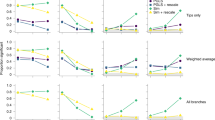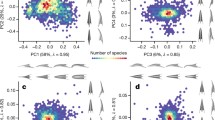Abstract
The hypothesis that evolution of body size in birds was a random process coupled with an absolute lower boundary on body mass was tested using data on 6217 species of extant birds. The test was based on the fact that subclades within birds that have body masses much larger than this minimum should not have skewed log body mass distributions, while clades close to this boundary should. Bird species were classified into 23 orders suggested by Sibley and Monroe (1988). Thirteen orders that had average log body masses greater than the average for all birds had significantly skewed log body mass distributions. This is inconsistent with the hypothesis that evolution of body size in birds is random, but is constrained only at the smallest body masses. Most orders of birds cannot be considered random samples from the parental distribution of all birds. When the pattern of body mass evolution in birds is reconstructed using an estimate of the phylogenetic relationships among orders, there are many more instances where a large taxon putatively originated from a smaller one than vice versa. The non-random nature of body mass evolution in birds is consistent with models that postulate that evolution is constrained by the ability of individuals to turn resources into offspring.
Similar content being viewed by others
References
Blackburn, T.M. and Gaston, K.J. (1994a) Animal body size distributions: Patterns, mechanisms and im-plications. Trends Ecol. Evol. 9, 471–474.
Blackburn, T.M. and Gaston, K.J. (1994b) The distribution of body sizes of the world's bird species. Oikos 70, 127–130.
Bonner, J.T. (1988) The Evolution of Complexity by Means of Natural Selection. University of Chicago Press, Chicago, IL.
Brooks, D.R. and McLennan, D.A. (1991) Phylogeny, Ecology, and Behavior. University of Chicago Press, Chicago, IL.
Brown, J.H. (1995) Macroecology. University of Chicago Press, Chicago, IL.
Brown, J.H. and Maurer, B.A. (1986) Body size, ecological dominance and Cope's Rule. Nature 324, 248–250.
Brown, J.H., Marquet, P.A. and Taper, M.L. (1993) Evolution of body size: Consequences of an energetic definition of fitness. Am. Nat. 142, 573–584.
Dial, K.P. and Marzlu., J.M. (1988) Are the smallest organisms the most diverse? Ecology 69, 1620–1624.
Dunning, J.B. (1993) CRC Handbook of Avian Body Masses. CRC Press, Boca Raton, FL.
Efron, B. and Tibshirani, R.J. (1993) An Introduction to the Bootstrap. Chapman & Hall, New York.
Fedducia, A. (1996) The Origin and Evolution of Birds. Yale University Press, New Haven, CT.
Gould, S.J. (1988) Trends as changes in variance: A new slant on progress and directionality in evolution. J. Paleontol. 62, 319–329.
Harvey, P.H. and Pagel, M.D. (1991) The Comparative Method in Evolutionary Biology. Oxford University Press, Oxford.
Jablonski, D. (1996) Body size and macroevolution. In Evolutionary Paleobiology (D. Jablonski, D.H. Erwin and J.H. Lipps, eds), pp. 256–289. University of Chicago Press, Chicago, IL.
Jablonski, D. (1997) Body-size evolution in Cretaceous molluscs and the status of Cope's rule. Nature 385, 250–252.
Kelt, D.A. and Brown, J.H. (1997) Diversification of body sizes: Patterns and processes in the assembly of terrestrial mammal faunas. In Biodiversity Dynamics (M.L. McKinney, ed.). Columbia University Press, New York.
Kozłowski, J. and Weiner, J. (1997) Interspecific allometries are by-products of body size optimization. Am. Nat. 149, 352–380.
Losos, J.B. (1990) Ecomorphology, performance capability, and scaling of West Indian Anolis lizards: An evolutionary analysis. Ecol. Monogr. 60, 369–388.
MacFadden, B.J. (1986) Fossil horses from `Eohippus' (Hyracotherium) to Equus: Scaling, Cope's Law, and the evolution of body size. Paleobiology 12, 355–369.
Maddison, W.P. (1991) Squared-change parsimony reconstructions of ancestral character states for contin-uous-valued characters on a phylogenetic tree. Syst. Zool. 40, 304–314.
Maddison, W.P. and Maddison, D.R. (1992) MacClade: Analysis of Phylogeny and Character Evolution. Sinauer, Sunderland, MA.
Maurer, B.A. (1998) The evolution of body size in birds. II: The role of reproductive power. Evol. Ecol. 12, 935–944.
Maurer, B.A. and Brown, J.H. (1988) Distribution of energy use and body mass among species of North American terrestrial birds. Ecology 69, 1923–1932.
Maurer, B.A., Brown, J.H. and Rusler, R.D. (1992) The micro and macro in body size evolution. Evolution 46, 939–953.
McKinney, M.L. (1990) Trends in body size evolution. In Evolutionary Trends (K.J. McNamara, ed.), pp. 75–118. University of Arizona Press, Tucson, AZ.
McShea, D.W. (1994) Mechanisms of large-scale evolutionary trends. Evolution 48, 1747–1763.
Miles, D.B. and Dunham, A.E. (1993) Historical perspectives in ecology and evolutionary biology: The use of phylogenetic comparative analyses. Annu. Rev. Ecol. Syst. 24, 587–619.
Sibley, C.G. and Ahlquist, J.E. (1990) Phylogeny and Classification of Birds. Yale University Press, New Haven, CT.
Sibley, C.G. and Monroe, B.L., Jr. (1990) Distribution and Taxonomy of Birds of the World. Yale University Press, New Haven, CT.
Sibley, C.G., Ahlquist, J.E. and Monroe, B.L. Jr. (1988) A classification of the living birds of the world based on DNA-DNA hybridization studies. Auk 105, 409–423.
Siegal-Causey, D. (1992) Review of distribution and taxonomy of birds. Auk 109, 939–944.
Sokal, R.R. and Rohlf, F.J. (1981) Biometry, 2nd edn. W.H. Freeman, New York.
Stanley, S.M. (1973) An explanation for Cope's Rule. Evolution 27, 1–26.
Swofford, D.L. and Maddison, W.P. (1987) Reconstructing ancestral character states under Wagner parsi-mony. Math. Biosci. 87, 199–229.
Van Valen, L. (1973) Body size and numbers of plants and animals. Evolution 27, 27–35.
Author information
Authors and Affiliations
Rights and permissions
About this article
Cite this article
Maurer, B.a. The evolution of body size in birds. I. Evidence for non-random diversification. Evolutionary Ecology 12, 925–934 (1998). https://doi.org/10.1023/A:1006512121434
Issue Date:
DOI: https://doi.org/10.1023/A:1006512121434




